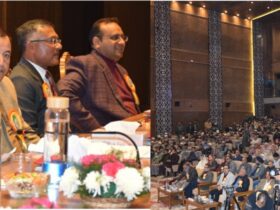Shahzad Hussain Hamdani
International Women’s Day (IWD), originally called International Working Women’s Day, is marked on March 8 every year.In different regions the focus of the celebrations ranges from general celebration of respect, appreciation and love towards women to a celebration for women’s economic, political and social achievements. Started as a Socialist political event, the holiday blended in the culture of many countries, primarily Eastern Europe, Russia, and the former Soviet bloc. In some regions, the day lost its political flavour, and became simply an occasion for men to express their love for women in a way somewhat similar to a mixture of Mother’s Day and Valentine’s Day. In other regions, however, the original political and human rights theme designated by the United Nations runs strong, and political and social awareness of the struggles of women worldwide are brought out and examined in a hopeful manner. The first national Women’s Day was observed on 28 February 1909 in the United States following a declaration by the Socialist Party of America. In August 1910, an International Women’s Conference was organized to precede the general meeting of the Socialist Second International inCopenhagen. Inspired in part by the American socialists, German Socialist Luise Zietz proposed the establishment of an annual ‘International Woman’s Day’ (singular) and was seconded by communist Clara Zetkin, although no date was specified at that conference. Delegates (100 women from 17 countries) agreed with the idea as a strategy to promote equal rights, including suffrage, for women.
The following year, on 18 March 1911, IWD was marked for the first time, by over a million people in Austria, Denmark, Germany and Switzerland. In the Austro-Hungarian Empire alone, there were 300 demonstrations. In Vienna, women paraded on the Ringstrasse and carried banners honouring the martyrs of the Paris Commune. Women demanded that women be given the right to vote and to hold public office. They also protested against employment sex discrimination. Americans continued to celebrate National Women’s Day on the last Sunday in February. Female members of the AustralianBuilders Labourers Federation march on International Women’s Day 1975 in Sydney In 1913 Russian women observed their first International Women’s Day on the last Sunday in February (by Julian calendar then used in Russia). In 1917 demonstrations marking International Women’s Day in Saint Petersburg on the last Sunday in February (which fell on 8 March on the Gregorian calendar) initiated the February Revolution.[1] Following the October Revolution, the Bolshevik Alexandra Kollontai persuaded Vladimir Lenin to make it an official holiday in the Soviet Union, and it was established, but was a working day until 1965.
On May 8, 1965 by the decree of the USSR Presidium of the Supreme Soviet International Women’s Day was declared a non-working day in the USSR “in commemoration of the outstanding merits of Soviet women in communistic construction, in the defence of their Fatherland during the Great Patriotic War, in their heroism and selflessness at the front and in the rear, and also marking the great contribution of women to strengthening friendship between peoples, and the struggle for peace. But still, women’s day must be celebrated as are other holidays.” From its official adoption in Russia following the Soviet Revolution in 1917 the holiday was predominantly celebrated in communist and socialist countries. It was celebrated by the communists in China from 1922, and by Spanish communists from 1936. After the founding of the People’s Republic of Chinaon October 1, 1949 the state council proclaimed on December 23 that March 8 would be made an official holiday with women in China given a half-day off. In the West, International Women’s Day was first observed as a popular event after 1977 when the United Nations General Assembly invited member states to proclaim March 8 as the UN Day for women›s rights and world peace.
Thus on every International Women Day, The United Nation frames a Official theme. Here is s list of such themes which has marked International Women day till date. International Women’s Day Official UN Themes Year UN Theme
1996-Celebrating the Past, Planning for the Future
1997-Women and the Peace Table
1998-Women and Human Rights
1999-World Free of Violence Against Women
2000-Women Uniting for Peace
2001-Women and Peace: Women Managing Conflicts
2002-Afghan Women Today: Realities and Opportunities
2003-Gender Equality and the Millennium Development Goals
2004-Women and HIV/AIDS
2005-Gender Equality Beyond 2005; Building a More Secure Future
2006-Women in Decision-making
2007-Ending Impunity for Violence Against Women and Girls
2008-Investing in Women and Girls
2009-Women and Men United to End Violence Against Women and Girls
2010-Equal Rights, Equal Opportunities: Progress for All
2011 -Equal Access to Education, Training, and Science and Technology: Pathway to Decent Work for Women
2012-Empower Rural Women, End Poverty and Hunger
In that year, Oxfam America invited people to celebrate inspiring women in their lives by sending a free International Women’s Day e-Card or honouring a woman whose efforts had made a difference in the fight against hunger and poverty with Oxfam’s International Women’s Day award. On the occasion of International Women’s Day 2012, the ICRC called for more action to help the mothers and wives of people who have gone missing during armed conflict. The vast majority of people who go missing in connection with conflict are men. As well as the anguish of not knowing what has happened to the missing person, many of these women face economic and practical difficulties. The ICRC underlined the duty of parties to a conflict to search for the missing and provide information for the families.
THE UN THEME FOR INTERNATIONAL WOMEN’S DAY 2013 IS “A PROMISE IS A PROMISE: TIME FOR ACTION TO END VIOLENCE AGAINST WOMEN,” WHILE INTERNATIONAL WOMEN’S DAY 2013 HAS DECLARED THE YEAR’S THEME AS THE GENDER AGENDA: GAINING MOMENTUM

















Leave a Reply